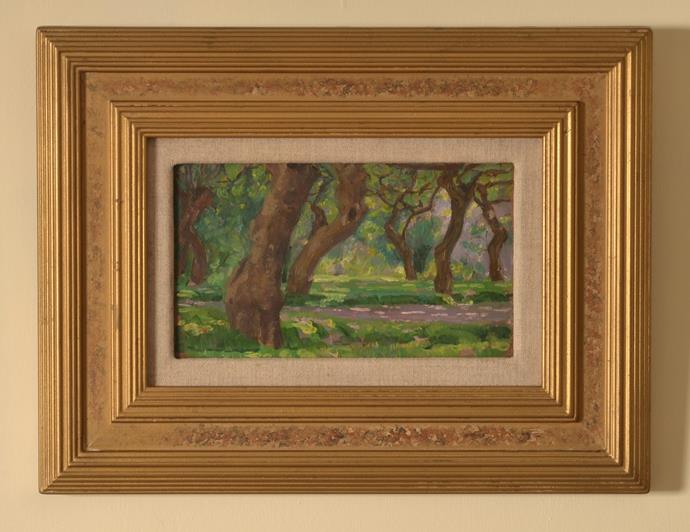A Shaded Path, Tahiti Arthur Studd
This intriguing little picture, painted in Tahiti, must date from 1897-8, when Studd joined Paul Gauguin in French Polynesia. Certainly, it betrays, in the bright array of greens in the vegetation and violets in the shadows, a sympathy with Gauguin’s advice to intensify and simplify the colour and composition. But, in fairness, one has to work quite hard to see much of Gauguin here. We should recall that, in 1897-8, Gauguin himself was embarking on some of his large, powerful, most philosophically-challenging, paintings, executed with darkly resonant colour, including The Dream, Nevermore and Where Do We Come From? What Are We? Where Are We Going? Furthermore, when Gauguin includes visions of the tropical forest of Tahiti, he tends to imbue the flora with a rather fantastic exoticism. Studd’s forest is full of life and energy – but we might not be surprised had we been given to understand that Studd were delighting in a woodland in England. Nevertheless, we know that Studd was entranced by Tahiti.
‘There are amazing things to paint - women who walk like goddesses - splendidly proportioned youths sitting in the moonlight … We have had beautiful cloudy weather ever since my arrival a month ago and the day would be for you full of sea pieces and the night of nocturnes.’[i]
And, extraordinarily enough - or, perhaps given the character of this lovely little painting, not surprising at all - this letter was addressed to James McNeill Whistler, Studd’s friend and neighbour in London, whom Studd dubbed, the ‘Master’. There can be no doubt that Studd’s Shaded Path, Tahiti is profoundly influenced by Whistler. The fluid paint, the brevity of the brushstroke, the enigmatic poetry, the composition which manages to combine a moment of absolute poise with an intense sense of vivid life – all of this reflects the impact of Whistler. I would also observe that Studd’s small touches of so many closely-related notes of green highlight an important aspect of the art of Whistler and many of his immediate colleagues: it was no accident that Whistler employed the words ‘Symphony’ and ‘Harmony’ in his titles (and no accident that Debussy, in turn, adopted the term ‘Nocturne’ for his compositions). Whistler’s handling of colour had been compared to musical notation in the mid-1860s; in 1877, Walter Pater had declared that, ‘All art constantly aspires towards the condition of music’[ii]. And, it is clear that Studd was thinking along the same lines here. What is more, Studd’s painting is on a small, wooden panel, of the kind frequently used by Whistler when he was working in the open, in the landscape or by the water. These panels were kept in an easily-portable, compact box - a ‘pochade box’ - which accommodates the panels and the palette and has a lid which conveniently converts into an easel. I like to imagine Arthur Studd wandering about Tahiti, chatting with Gauguin, carrying with his little box of panels, painting on the spot and enjoying an imaginary exchange of ideas with Whistler.
[i] Glasgow University, B.P. II S/52, letter dated 22 June, 1897
[ii] Walter Pater, 'The school of Giorgione', Fortnightly Review, 1877
12cms x 21cms
29cms x 38cms

